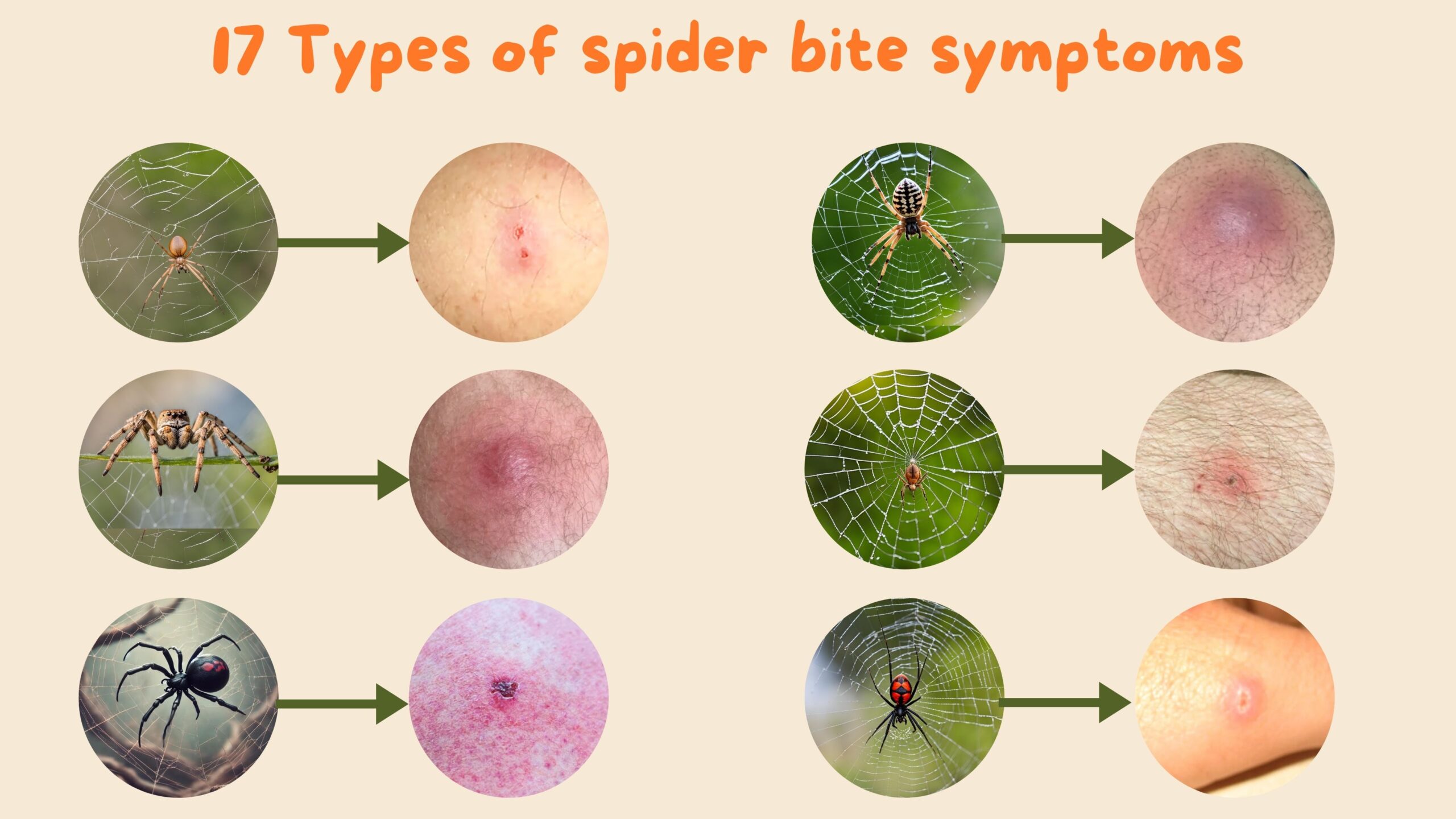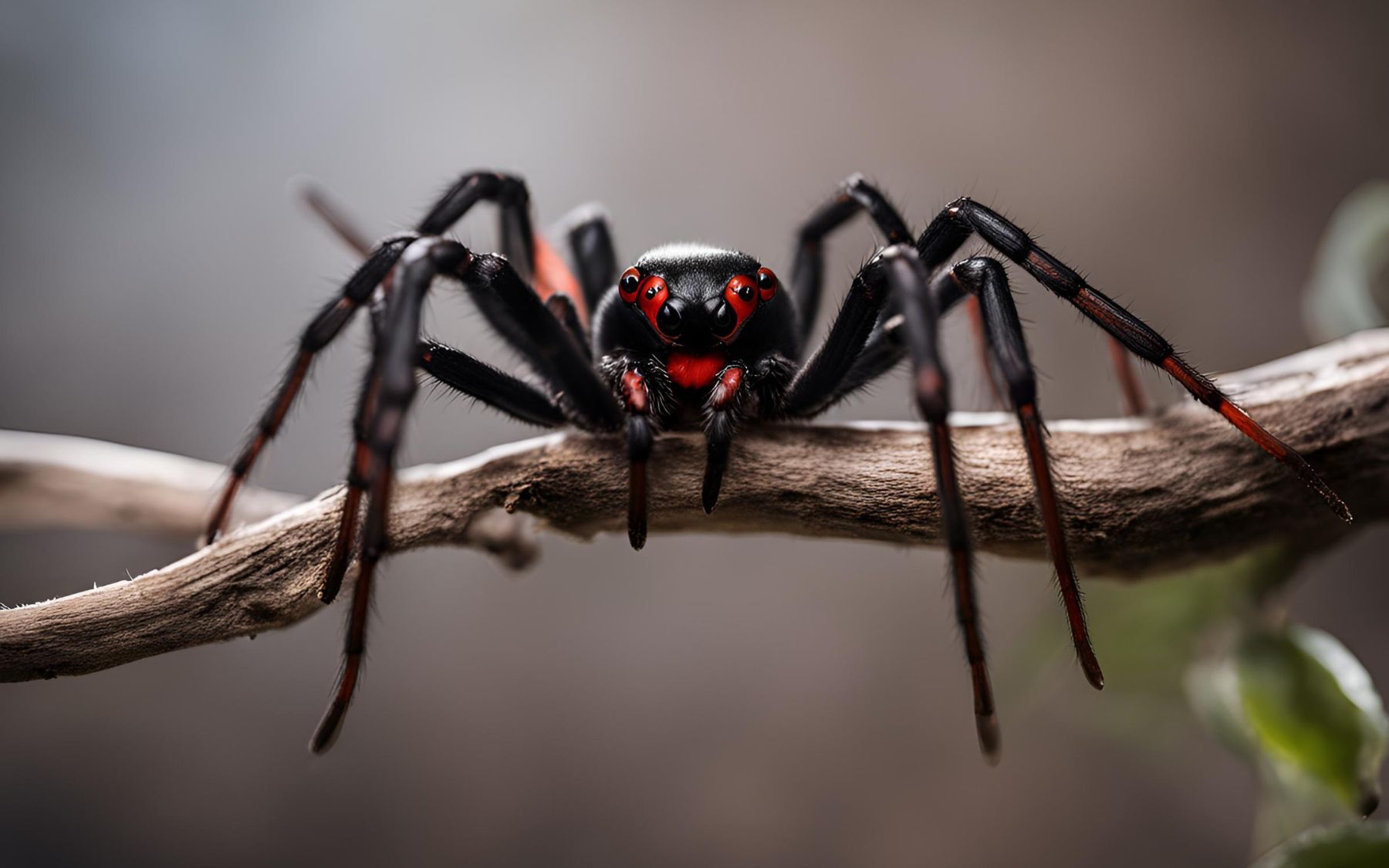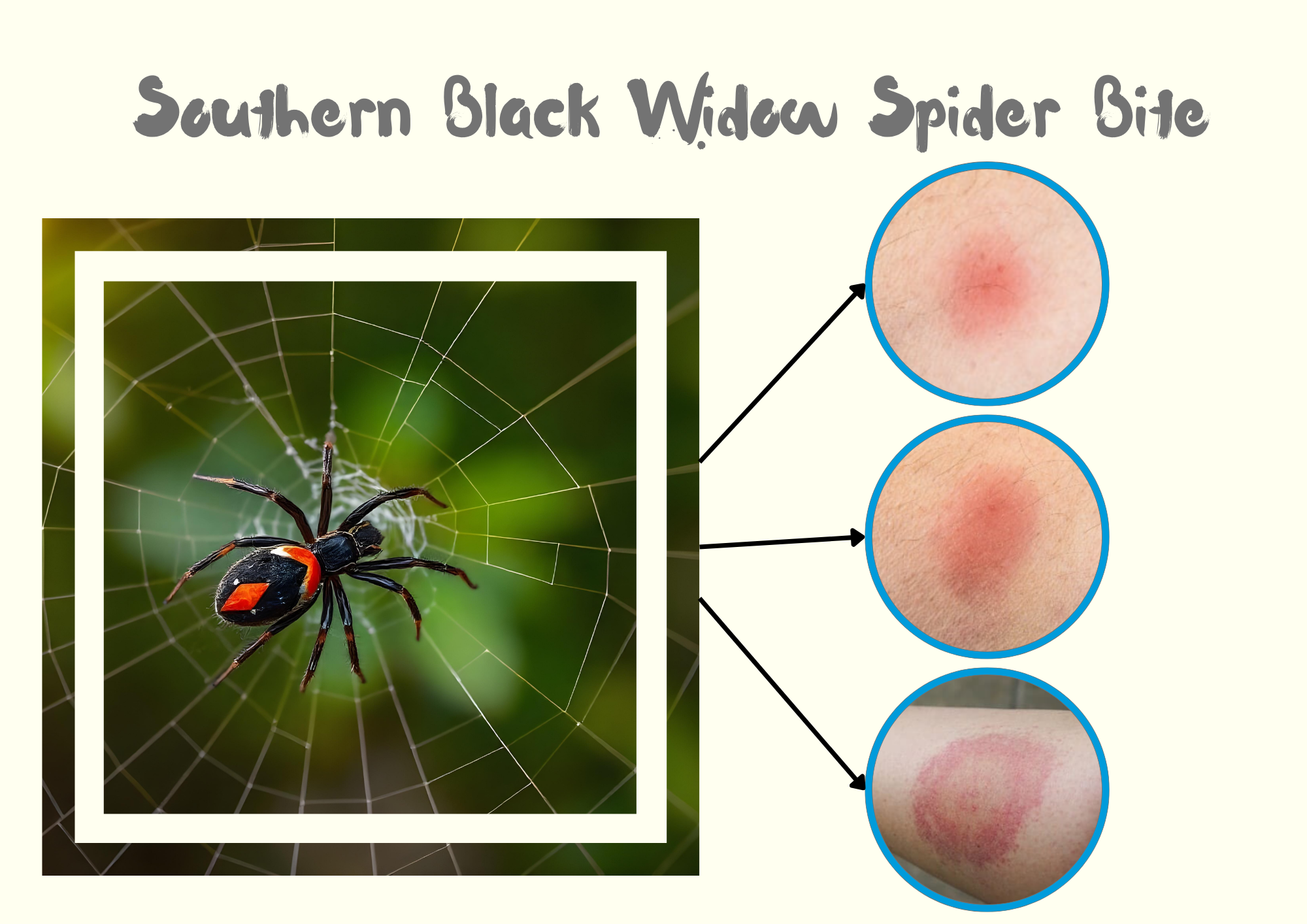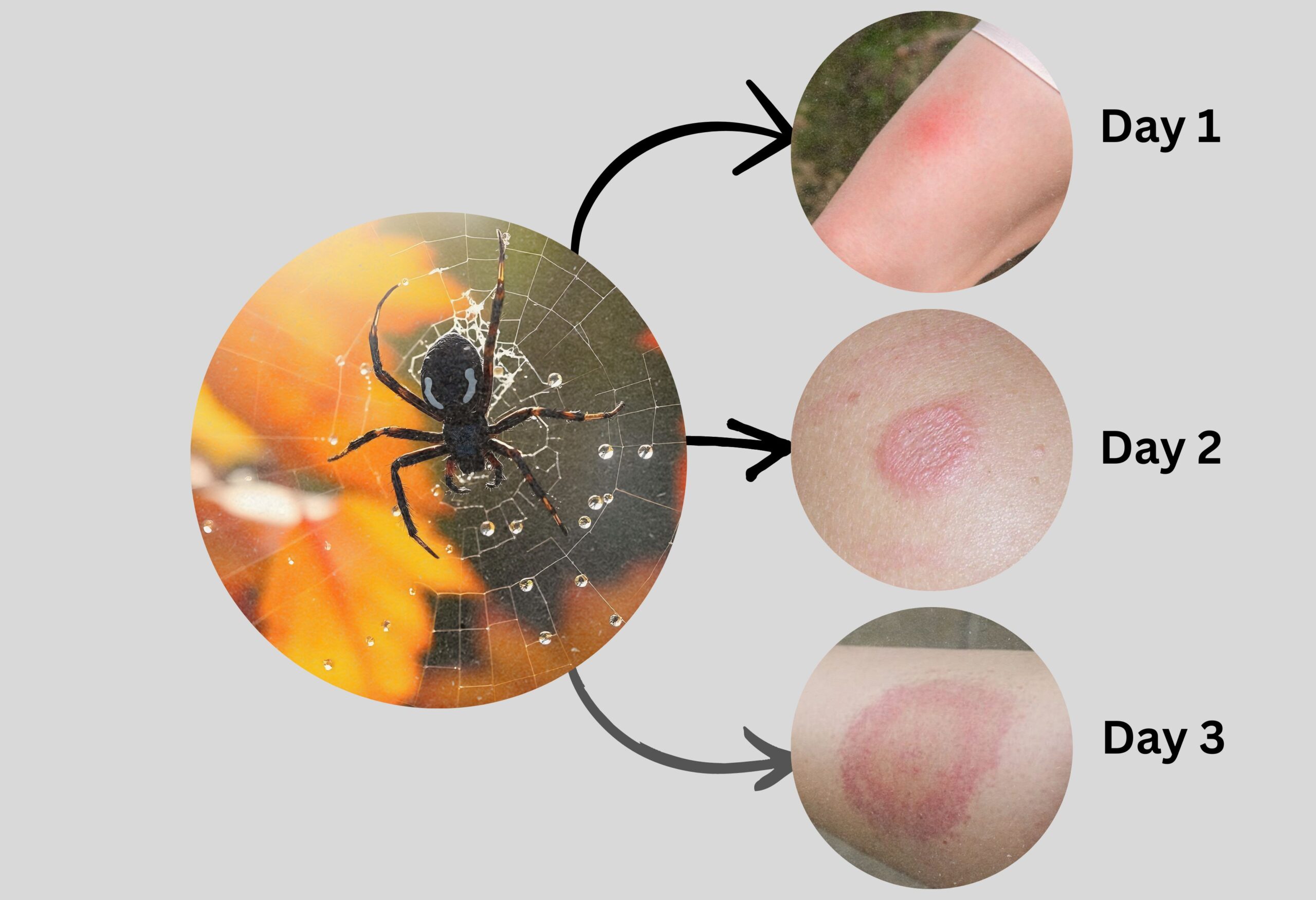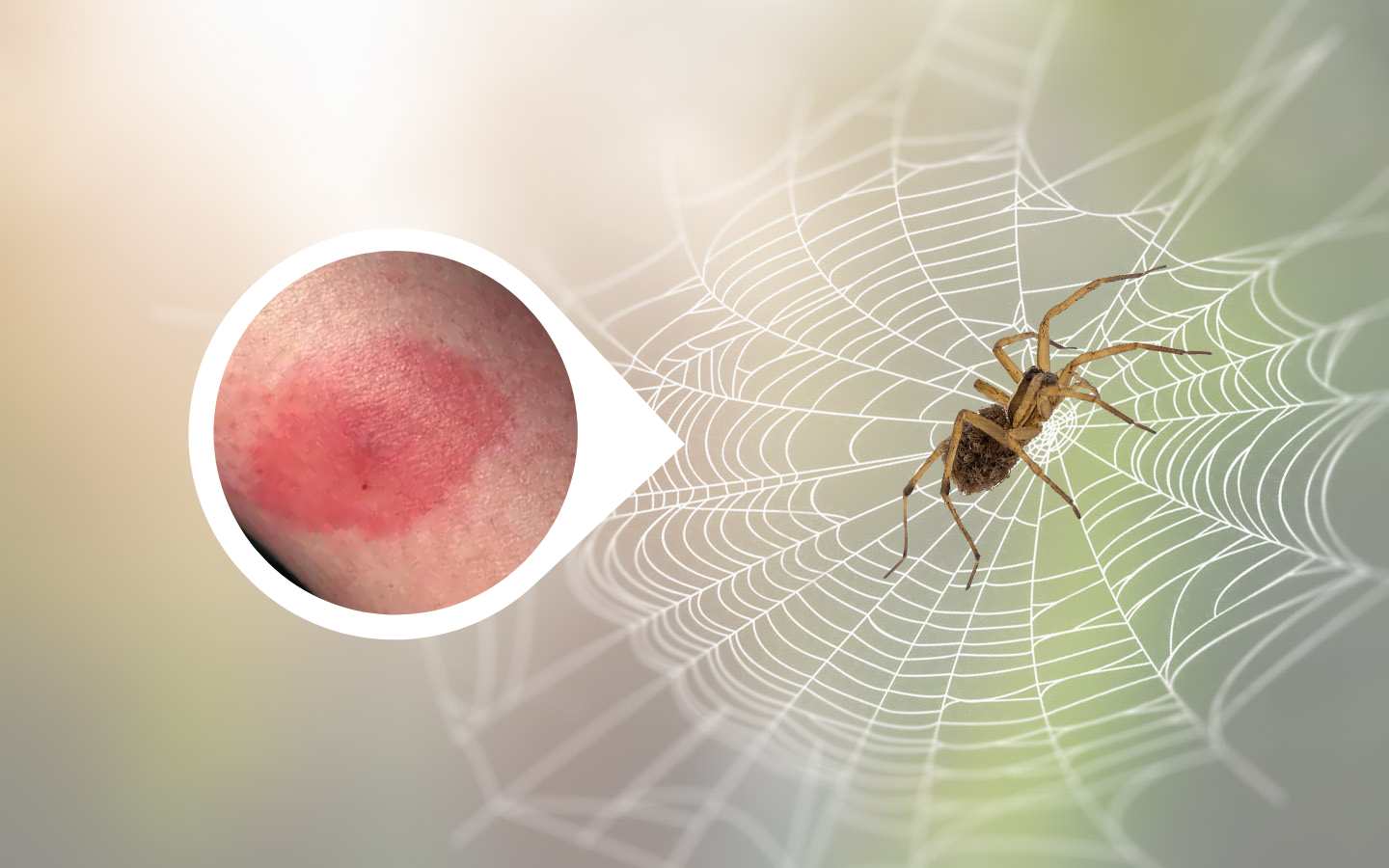Spider bites are often harmless and may cause mild symptoms like itching, redness, and slight pain. However, some spider bites can lead to serious health complications, especially those from venomous species like the brown recluse, black widow, or Brazilian wandering spider. Recognizing the serious symptoms of a spider bite is crucial for timely medical intervention, which can prevent the progression of severe reactions.
Understanding the stages of a spider bite, from initial contact to advanced symptoms, helps in identifying the need for urgent care. While most bites resolve on their own, certain warning signs indicate that the bite is more serious than it initially appears. Knowing how long after a spider bite you should worry, and how to determine if the bite requires immediate attention, is essential in managing potential complications.
Spider Bite Symptoms Identification
This guide will explore the serious symptoms of spider bites, outline the stages of a typical spider bite, and help you understand when to seek medical advice. Early detection and appropriate action can make a significant difference in recovery and prevent more severe outcomes from developing.
1. Brown Recluse Spider Bite Symptoms
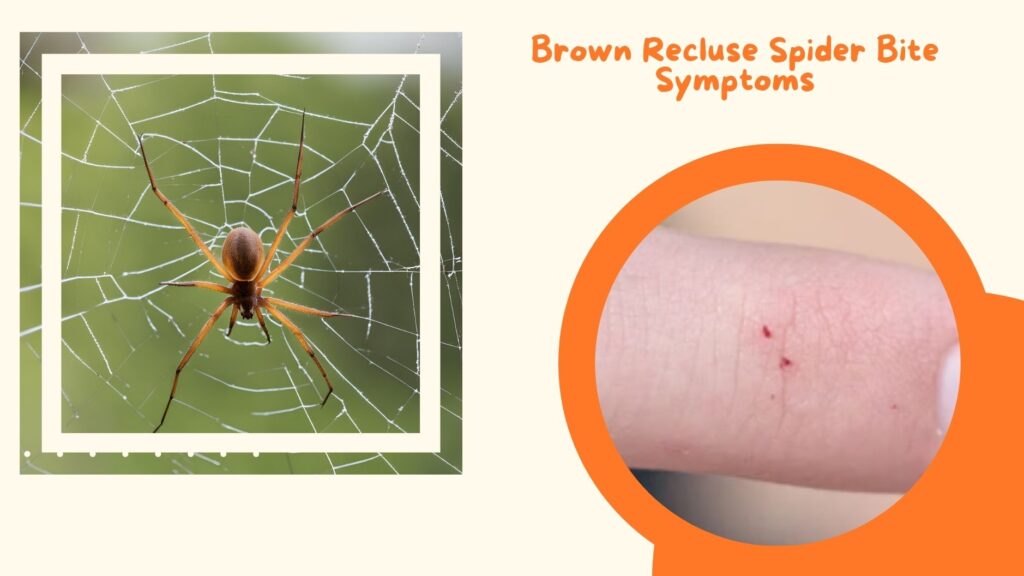
Description of the Spider: The Brown Recluse spider, identifiable by its violin-shaped marking, is a small, brown spider commonly found in the southern and central U.S. It prefers dark, undisturbed areas like basements and attics and typically bites when disturbed.
Common Symptoms: Initially, a bite may be painless, but within hours, symptoms like redness, pain, and itching develop. The bite area may form a blister that breaks open, revealing an ulcer-like sore. In severe cases, necrosis, or tissue death, can occur, leading to an open wound that heals slowly.
Severe Reactions: More serious symptoms include fever, chills, and body aches, particularly in vulnerable individuals such as children and the elderly. These systemic reactions indicate the venom is affecting the body beyond the bite site, necessitating immediate medical attention.
2. Wolf Spider Bite Symptoms
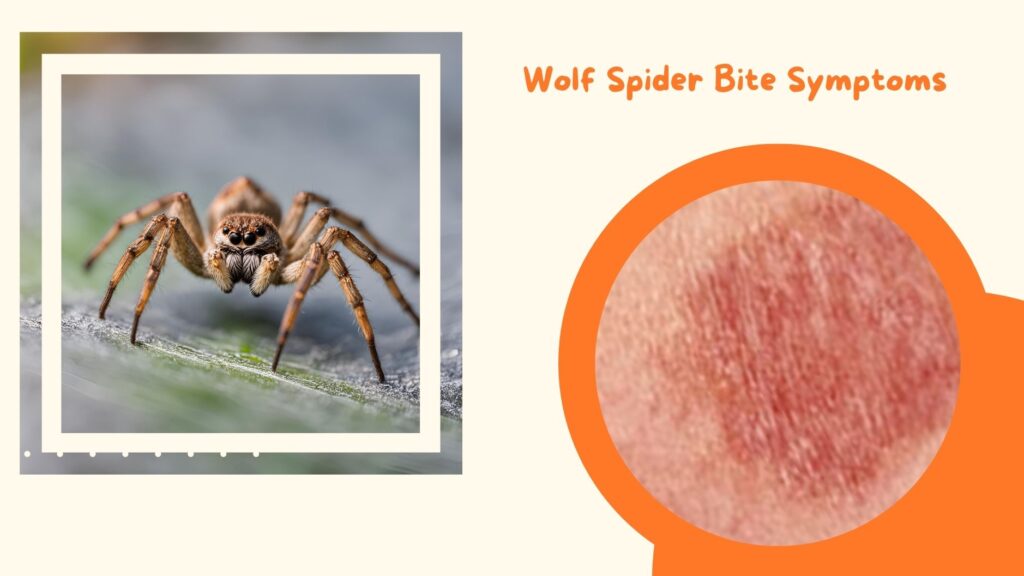
Description of the Spider:
Wolf spiders are large, hairy spiders that are usually brown, gray, or black with distinct stripe patterns. Found across various habitats worldwide, they are ground dwellers and often mistaken for tarantulas due to their size. Wolf spiders do not spin webs; instead, they hunt prey actively.
Common Symptoms:
Wolf spider bites are generally not dangerous but can be painful. Common symptoms include redness, swelling, and mild to moderate pain at the bite site. Itching and a burning sensation may also occur, and the bite area may feel tender or warm to the touch.
Severe Reactions:
While rare, severe reactions may involve nausea, dizziness, or an allergic response, such as difficulty breathing or swelling away from the bite site. These symptoms are uncommon but should be monitored closely, especially if they worsen, warranting medical attention.
3. Black Widow Spider Bite Symptoms
Description of the Spider:
The Black Widow spider is easily recognizable by its shiny black body and distinctive red hourglass marking on the underside of its abdomen. These spiders are commonly found in dark, sheltered areas such as woodpiles, sheds, and garages, primarily in the southern and western United States.
Common Symptoms:
A Black Widow bite often feels like a pinprick, followed by immediate pain at the bite site. Symptoms usually progress within an hour, including redness, swelling, and cramping around the bite area. Pain may spread to the chest, abdomen, or back, often described as intense and severe.
Severe Reactions:
Serious symptoms include muscle cramps, nausea, vomiting, sweating, tremors, and elevated blood pressure. In severe cases, individuals may experience difficulty breathing, weakness, or fainting. These symptoms are particularly dangerous for children, the elderly, and those with compromised health, requiring urgent medical care.
4. Allergic Reaction Spider Bite Symptoms
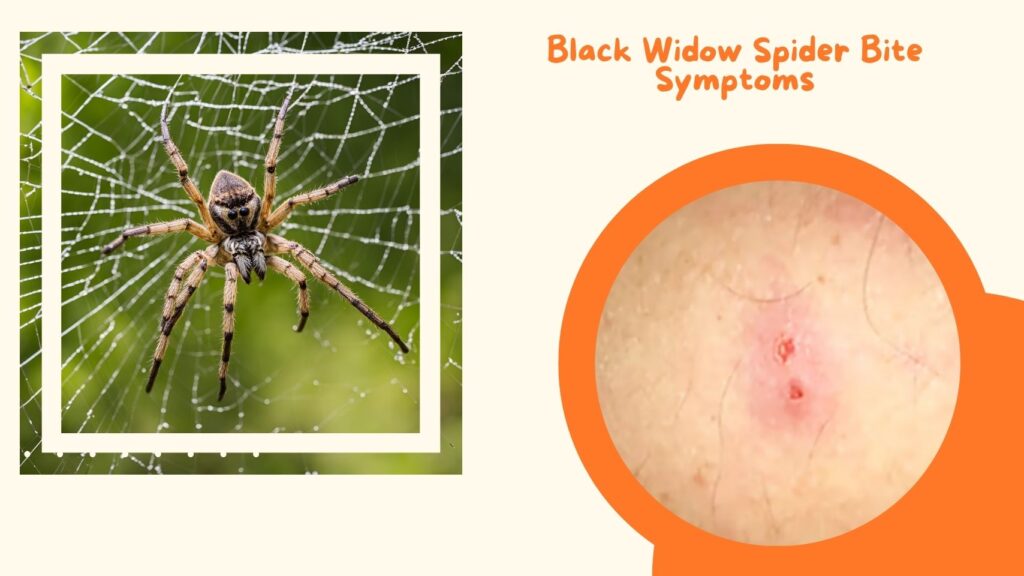
Description of the Reaction:
An allergic reaction to a spider bite can occur when the body’s immune system overreacts to the spider’s venom. This reaction can happen with any spider bite but is more common with venomous species. The severity of allergic reactions can vary widely depending on the individual’s sensitivity.
Common Symptoms:
Mild allergic reactions typically involve localized symptoms such as redness, swelling, itching, and pain at the bite site. The area may feel warm and tender to the touch, and a mild rash can also develop.
Severe Reactions:
Serious allergic reactions can include systemic symptoms such as difficulty breathing, swelling of the face, lips, or throat, rapid heartbeat, dizziness, and severe itching away from the bite site. These symptoms may indicate anaphylaxis, a life-threatening condition that requires immediate medical attention, as it can escalate quickly and affect breathing and circulation.
5. Poisonous Spider Bite Symptoms
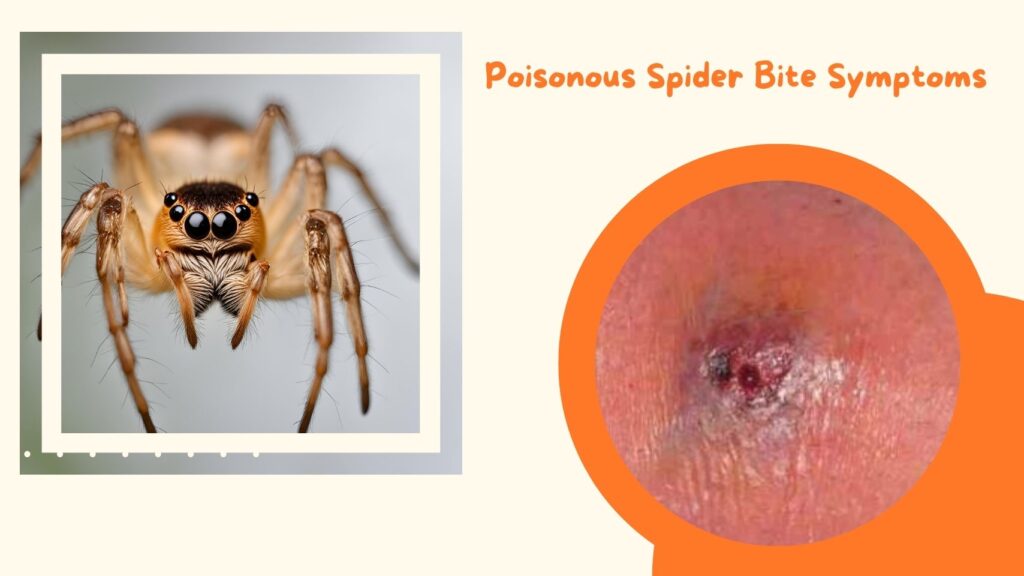
Description of the Reaction:
Poisonous spider bites come from species whose venom can cause harm to humans. These spiders include well-known venomous species like the brown recluse, black widow, and others. The venom can cause localized and systemic effects depending on the type and amount of venom injected.
Common Symptoms:
Symptoms of a poisonous spider bite often start with mild pain, redness, and swelling at the site of the bite. Blisters may form, and the area can become increasingly painful over time. Itching and a burning sensation are also common.
Severe Reactions:
In severe cases, the venom can lead to symptoms beyond the bite site, such as muscle cramps, fever, nausea, headaches, and fatigue. More serious systemic effects can include difficulty breathing, high blood pressure, sweating, and severe pain that radiates to other parts of the body, requiring urgent medical intervention.
6. Recluse Spider Bite Symptoms
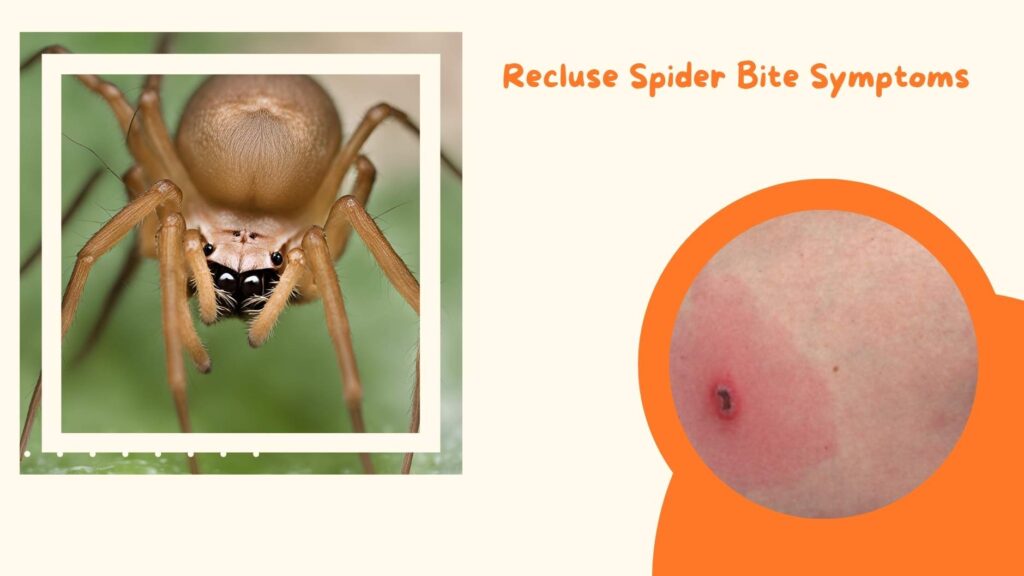
Description of the Spider:
Recluse spiders, including the brown recluse, are small, tan to dark brown spiders with a characteristic violin-shaped marking on their back. They are typically found in quiet, dark places such as basements, attics, and closets, where they avoid human contact.
Common Symptoms:
A recluse spider bite often starts as a mild sting or a painless bite, followed by redness, swelling, and itching. Within a few hours, the area may develop a blister that breaks open, leaving an ulcer-like sore that can grow larger if not treated.
Severe Reactions:
Severe symptoms include significant tissue damage (necrosis) around the bite, which can lead to an open wound that may take months to heal. Systemic symptoms such as fever, chills, nausea, joint pain, and general body aches may also occur, indicating that the venom is affecting the body beyond the bite site. Immediate medical attention is necessary if these symptoms develop to prevent further complications.
7. Yellow Sac Spider Bite Symptoms
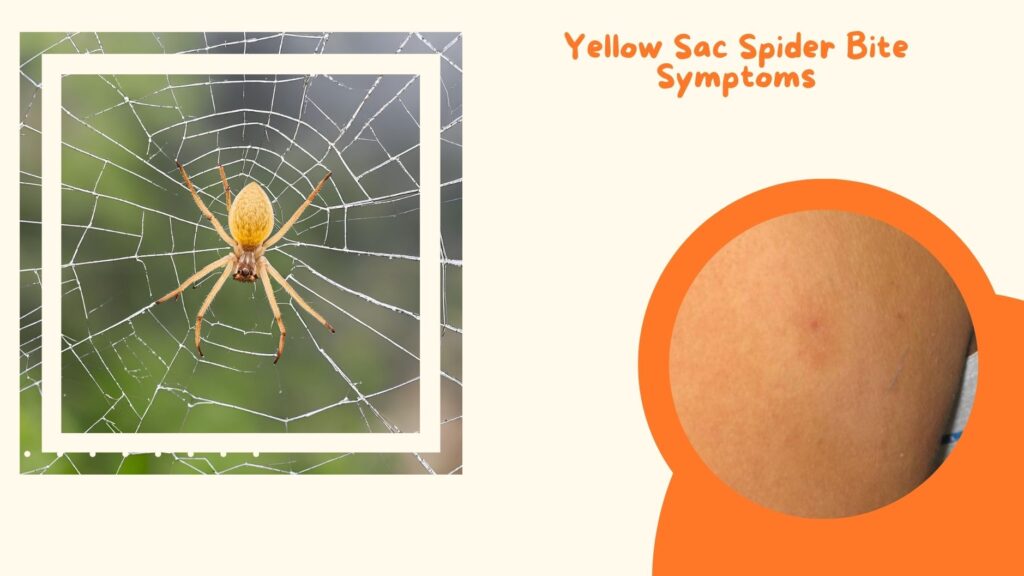
Description of the Spider:
Yellow sac spiders are small, pale yellow or light green spiders often found in homes, gardens, and wooded areas. They build small, silken sacs for resting during the day and are most active at night. These spiders are known to be mildly aggressive and will bite when disturbed.
Common Symptoms:
A yellow sac spider bite typically causes immediate, sharp pain similar to a bee sting, followed by redness and localized swelling. Itching is common, and the bite site may develop a small, firm bump or blister that can be tender to the touch.
Severe Reactions:
Though usually not serious, some individuals may experience more severe reactions, including prolonged pain, larger swelling, and signs of mild necrosis around the bite site. In rare cases, systemic symptoms such as headache, nausea, or mild fever may occur, indicating a need for medical evaluation, especially if symptoms worsen over time.
8. Hobo Spider Bite Symptoms
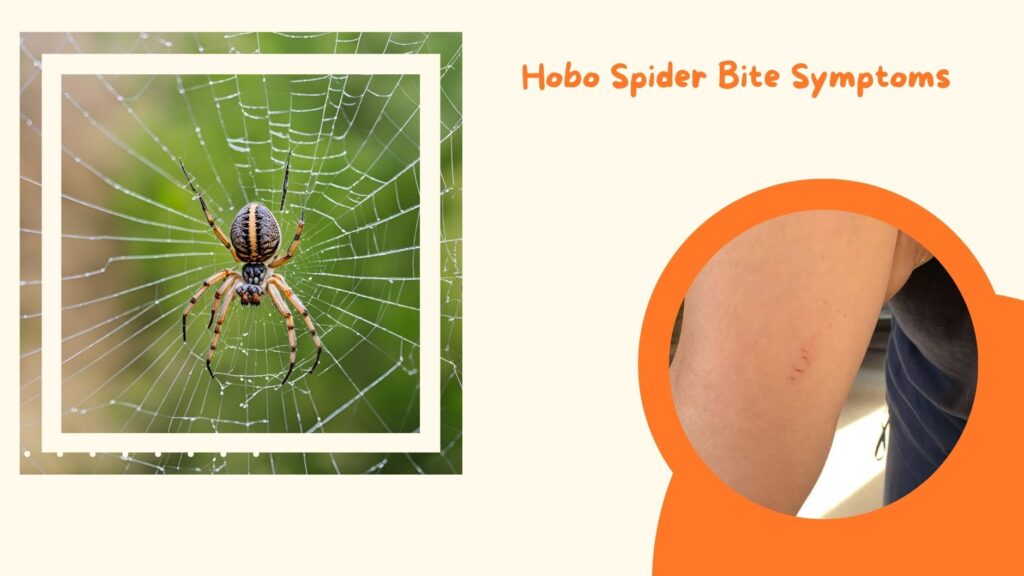
Description of the Spider:
The Hobo spider is a medium-sized, brown spider with a distinctive herringbone pattern on its abdomen. Commonly found in the Pacific Northwest of the United States, these spiders build funnel-shaped webs near ground level, often in basements, garages, and other secluded areas.
Common Symptoms:
A Hobo spider bite may initially go unnoticed or cause a mild stinging sensation. Within a few hours, the bite site may become red and swollen, with a blister forming in the center. As the blister breaks, an open sore may develop, which can slowly enlarge and become painful.
Severe Reactions:
Severe symptoms are uncommon but may include intense headache, fatigue, nausea, and, in rare cases, necrosis around the bite site. The wound can become slow to heal and may leave a scar. While serious complications are rare, it’s important to monitor the bite and seek medical care if symptoms worsen or if systemic effects such as fever or dizziness occur.
9. Brazilian Wandering Spider Bite Symptoms
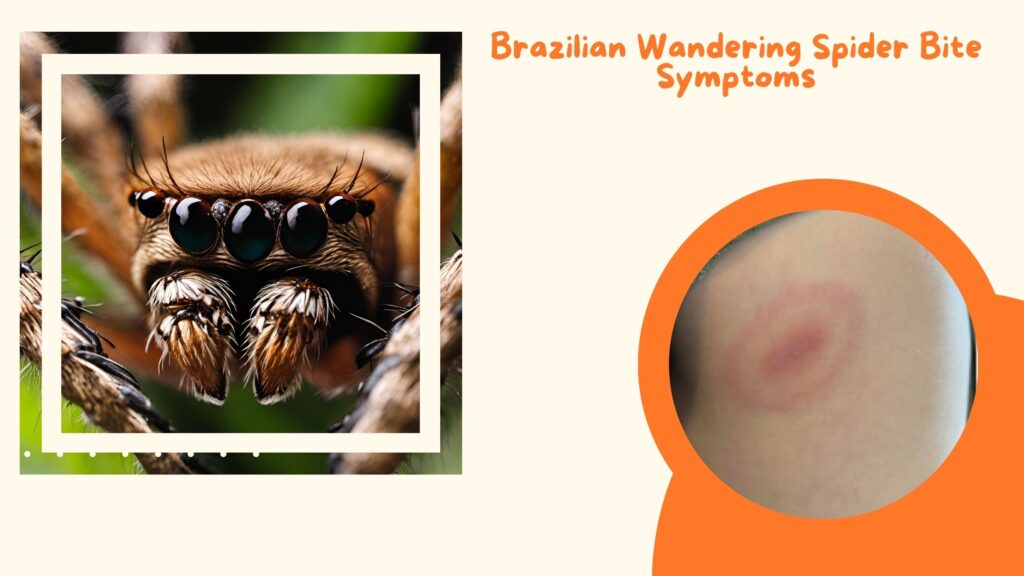
Description of the Spider:
The Brazilian wandering spider, known as one of the most venomous spiders in the world, is large and hairy with a leg span of up to 15 cm. These spiders are aggressive and do not stay in webs, actively wandering the jungle floors of Central and South America, often hiding in banana plants, earning them the nickname “banana spider.”
Common Symptoms:
A bite from a Brazilian wandering spider is extremely painful, often described as a burning sensation at the bite site. Symptoms can develop rapidly, including redness, swelling, and intense pain that can spread to the surrounding area.
Severe Reactions:
The venom can cause severe systemic symptoms such as excessive sweating, nausea, abdominal cramps, increased heart rate, and elevated blood pressure. In severe cases, it can lead to breathing difficulties, muscle paralysis, and even death if left untreated, especially in children and the elderly. Immediate medical attention is essential following a bite to prevent life-threatening complications.
10. Red House Spider Bite Symptoms
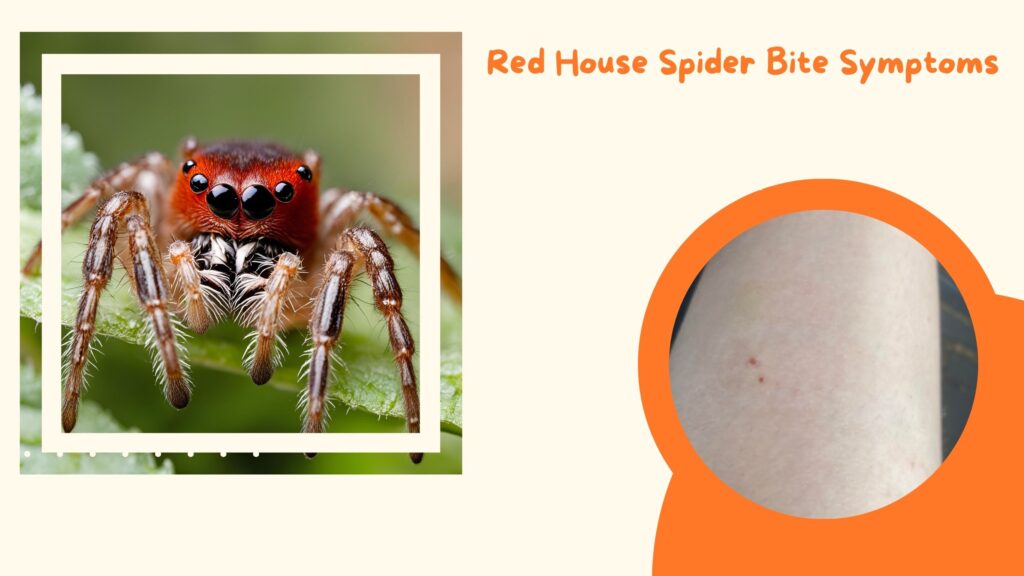
Description of the Spider:
The Red House spider is a small, reddish-brown spider commonly found indoors, particularly in basements, attics, and other quiet corners of the home. It closely resembles the black widow but is less dangerous and more common in urban areas.
Common Symptoms:
A bite from a Red House spider usually causes mild symptoms such as localized redness, slight swelling, and itching. The pain is typically mild to moderate, similar to a bee sting, and usually subsides within a few hours.
Severe Reactions:
While serious reactions are rare, some individuals may experience more intense symptoms, including prolonged swelling, blistering, or a mild rash around the bite site. In very rare cases, an allergic reaction can occur, characterized by increased pain, dizziness, or mild systemic symptoms like headache and nausea, warranting medical evaluation if symptoms persist or worsen.
11. Venomous Spider Bite Symptoms
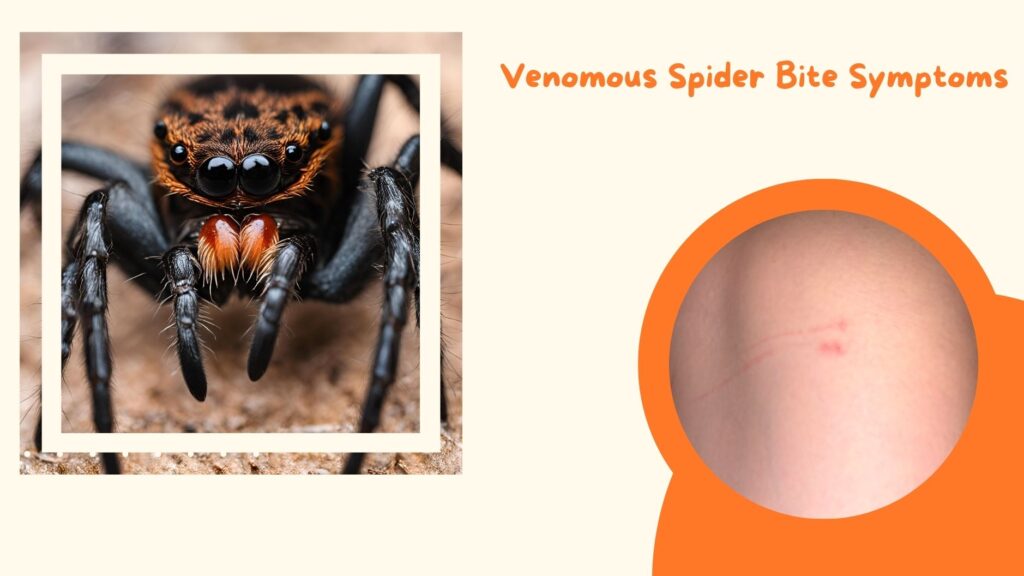
Description of the Reaction:
Venomous spiders inject venom that can cause harmful effects on the human body. The severity of symptoms varies depending on the type of spider, the amount of venom injected, and the individual’s sensitivity. Common venomous spiders include species like the black widow, brown recluse, and Brazilian wandering spider.
Common Symptoms:
Symptoms of venomous spider bites often begin with immediate pain, redness, and swelling at the bite site. As the venom spreads, blisters may form, and the area can become increasingly tender. Itching and a burning sensation are common and may be accompanied by localized muscle pain.
Severe Reactions:
Severe symptoms may include muscle cramps, intense pain spreading to other body parts, fever, nausea, vomiting, and excessive sweating. More serious effects, such as difficulty breathing, high blood pressure, rapid heartbeat, and even paralysis, can occur in extreme cases, particularly if left untreated, necessitating urgent medical care to prevent life-threatening complications.
12. Jumping Spider Bite Symptoms
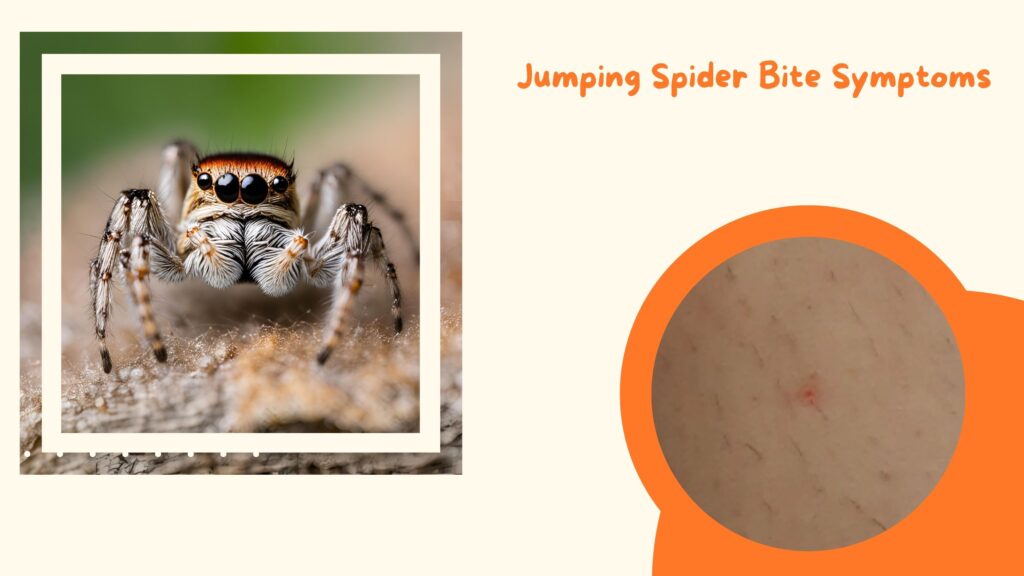
Description of the Spider:
Jumping spiders are small, brightly colored spiders known for their distinctive jerky movements and excellent vision. They are usually found outdoors on plants, fences, and windowsills but may occasionally venture indoors. Although they are capable of biting, they are not aggressive and typically bite only in self-defense.
Common Symptoms:
Jumping spider bites are generally harmless, with symptoms including mild pain, redness, and localized swelling at the bite site. The bite may resemble a small, raised bump that is tender to the touch. Itching is also common but usually subsides within a few hours to a couple of days.
Severe Reactions:
Severe reactions to jumping spider bites are rare, but some individuals may experience an allergic response, including prolonged swelling, increased redness, and itching that spreads beyond the bite site. Systemic symptoms such as headache, nausea, or dizziness are uncommon but should be monitored, especially if they worsen, indicating a need for medical evaluation.
13. Banana Spider Bite Symptoms
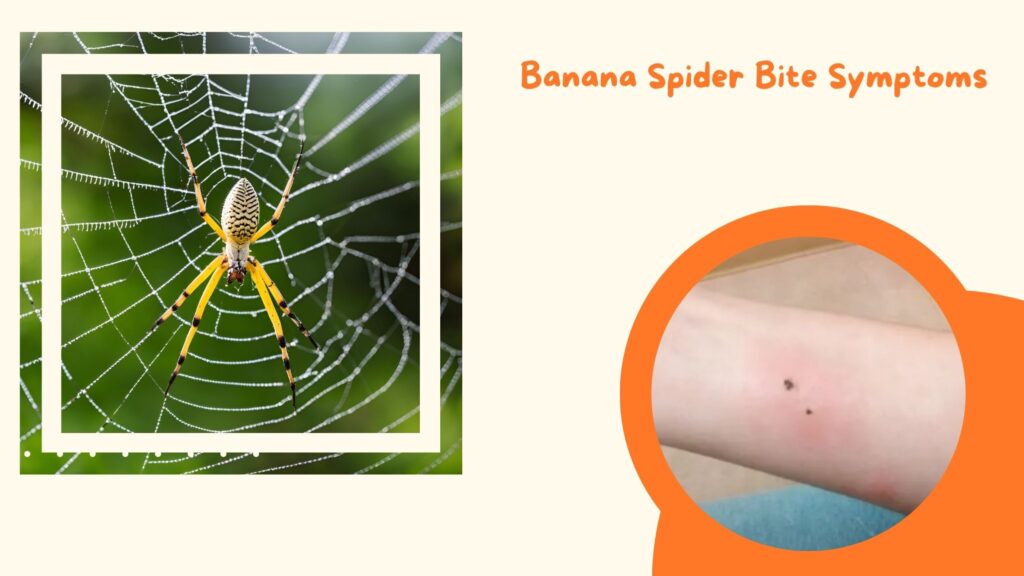
Description of the Spider:
Banana spiders, also known as golden silk orb-weavers, are large, brightly colored spiders commonly found in warm climates, particularly in forests and gardens. These spiders are known for their impressive webs and striking yellow and black coloration. Although intimidating in appearance, their bites are rarely dangerous.
Common Symptoms:
A banana spider bite typically causes immediate, sharp pain followed by redness, slight swelling, and mild itching at the bite site. The discomfort usually subsides within a few hours, leaving only minor irritation or a small red bump.
Severe Reactions:
Severe symptoms are uncommon but may include prolonged pain, increased swelling, or mild systemic effects like headache, dizziness, or nausea. These reactions are rare and usually mild, but if symptoms escalate or involve difficulty breathing or extensive swelling, medical attention may be necessary to rule out an allergic reaction.
Black House Spider Bite Symptoms
Description of the Spider:
The Black House spider is a dark, hairy spider commonly found in Australia and nearby regions. These spiders build messy, funnel-shaped webs around windows, doors, and other sheltered areas. Although they are often mistaken for more dangerous species, Black House spiders are generally not aggressive and bite only when provoked.
Common Symptoms:
A bite from a Black House spider typically results in mild to moderate pain, redness, and localized swelling. The pain may feel similar to a bee sting and is often accompanied by itching and tenderness around the bite area. Symptoms usually resolve within a few days.
Severe Reactions:
While most bites are not serious, some individuals may experience more intense reactions, including nausea, dizziness, or headache. Rarely, prolonged pain or extensive swelling may occur, indicating an allergic response. If symptoms persist or worsen, especially if systemic effects develop, seeking medical attention is recommended.
False Widow Spider Bite Symptoms
Description of the Spider:
False widow spiders are medium-sized, dark spiders with a bulbous abdomen, often mistaken for the more dangerous black widow due to their similar appearance. They are commonly found in Europe and parts of the United States, residing in houses, sheds, and gardens. False widows are not aggressive but will bite in self-defense.
Common Symptoms:
A false widow spider bite typically causes mild to moderate pain, similar to a wasp sting, with redness, swelling, and itching at the bite site. The affected area may feel warm and tender, and in some cases, a small blister may form.
Severe Reactions:
Severe symptoms, although rare, can include intense pain, muscle cramps, fever, and nausea. Some individuals may experience localized numbness or tingling. If systemic symptoms develop, such as dizziness or difficulty breathing, medical attention should be sought promptly, particularly for those with underlying health conditions or known allergies to spider venom.
Huntsman Spider Bite Symptoms
Description of the Spider:
Huntsman spiders are large, fast-moving spiders with long legs, often found in warm climates worldwide, including Australia, Asia, and Africa. They are usually brown or gray with various patterns and prefer hiding in crevices, under rocks, or inside homes. Despite their intimidating size, huntsman spiders are generally non-aggressive and bite only when threatened.
Common Symptoms:
A huntsman spider bite can cause immediate, mild to moderate pain at the bite site, accompanied by localized redness and slight swelling. Itching is also common, and the pain usually resembles that of a bee sting, subsiding within a few hours.
Severe Reactions:
Severe reactions are uncommon but may include prolonged pain, headache, nausea, or mild dizziness. Rarely, an allergic reaction can cause more significant swelling and discomfort. While huntsman spider bites are typically not dangerous, monitoring the bite for worsening symptoms is important, and medical attention should be sought if unusual or severe reactions occur.
Conclusion
Recognizing spider bite symptoms is crucial for timely intervention and effective treatment. While most spider bites are harmless and cause only mild symptoms, bites from venomous species or severe allergic reactions can lead to significant health issues, including necrosis, systemic symptoms, and even life-threatening conditions. Understanding the symptoms associated with different spider bites can help individuals identify when a bite requires medical attention and prevent complications from developing.
Recommendations for Seeking Medical Attention:
If you experience severe pain, intense swelling, difficulty breathing, fever, muscle cramps, or any symptoms that worsen over time, seek immediate medical care. Early medical intervention is especially important for bites from venomous spiders, such as the brown recluse or black widow, and for those who are more vulnerable, including children, the elderly, or individuals with compromised immune systems.
Preventive Measures to Avoid Spider Bites:
- Avoid areas where spiders are likely to live, such as dark, undisturbed spaces, piles of wood, or cluttered areas.
- Use gloves and protective clothing when working in gardens, basements, or other spider-prone areas.
- Regularly clean and declutter storage areas, garages, and sheds to reduce hiding spots.
- Seal cracks and gaps around doors, windows, and foundations to prevent spiders from entering your home.
- Shake out shoes, clothing, and bedding before use, especially if stored in areas where spiders are common.
By being vigilant and taking preventive measures, you can reduce the risk of spider bites and ensure prompt response in the event of a bite, protecting your health and well-being.

